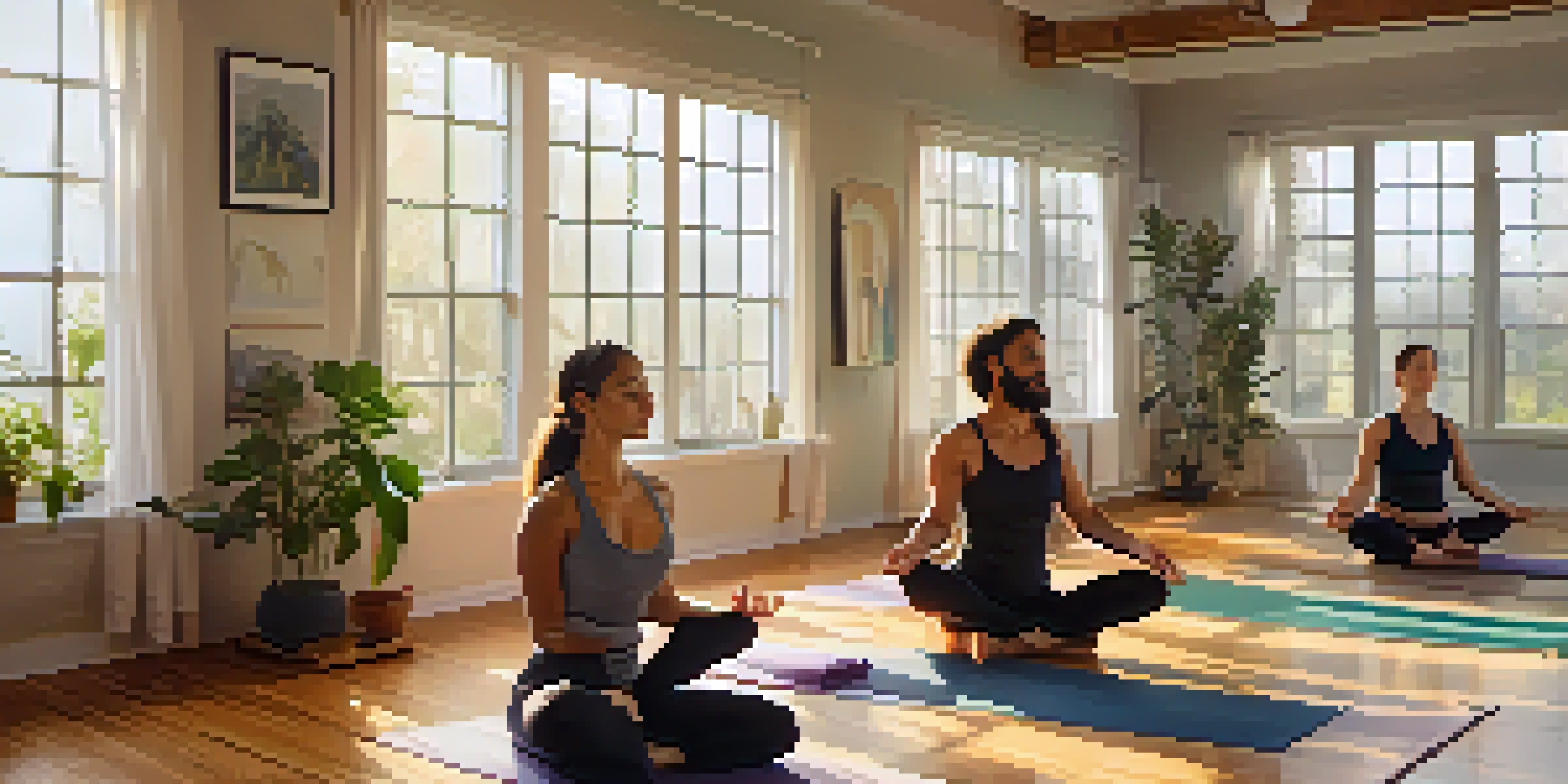Breath Control: A Key to Building Resilience Through Yoga

Understanding Breath Control in Yoga
Breath control, or pranayama, is a fundamental aspect of yoga that focuses on regulating breath. In yoga, the breath serves as a bridge between the mind and body, allowing practitioners to tap into their inner strength. By learning to control breathing patterns, individuals can enhance their overall physical and mental well-being.
The breath is the bridge which connects life to consciousness, which unites your body to your thoughts.
When we practice breath control, we become more aware of our body’s responses to stress and emotions. This awareness is crucial for developing resilience, as it enables us to manage challenges with greater ease. Just like a musician learns to control their instrument, yoga practitioners refine their breath to improve their practice and daily life.
Moreover, breath control techniques can help us navigate difficult situations by promoting calmness and clarity. For instance, deep breathing can lower heart rates and reduce feelings of anxiety. Thus, understanding and practicing breath control is the first step in building resilience through yoga.
The Connection Between Breath and Resilience
Resilience is often defined as the ability to bounce back from adversity, and breath control plays a pivotal role in this process. When faced with stress, our breath tends to become shallow and rapid, which can exacerbate feelings of anxiety. By consciously regulating our breath, we can counteract these physiological responses and foster a sense of calm.

Think of breath as a tool for emotional regulation. Just as a captain steers a ship through turbulent waters, controlled breathing helps us navigate life's challenges. For example, practicing slow, deep breaths can activate the parasympathetic nervous system, promoting relaxation and helping us approach problems with a clearer mind.
Breath Control Enhances Resilience
Practicing breath control helps individuals manage stress and develop resilience in challenging situations.
Ultimately, mastering breath control allows us to respond to stressors more effectively, enhancing our capacity to recover from setbacks. This connection highlights why integrating breathwork into our yoga practice is essential for building resilience.
Techniques for Effective Breath Control
There are several techniques for breath control that can be easily incorporated into a yoga practice. One popular method is diaphragmatic breathing, which involves fully engaging the diaphragm while inhaling deeply. This technique not only enhances oxygen flow but also promotes relaxation and reduces tension in the body.
Breath is the finest gift of nature. Be grateful for this wonderful gift.
Another effective technique is box breathing, where you inhale for a count of four, hold for four, exhale for four, and pause for another four. This structured approach helps to calm the mind and can be particularly useful in stressful situations. By practicing these techniques regularly, we can develop a more resilient mindset over time.
It's important to remember that consistency is key. Just like building muscle strength, developing breath control requires regular practice. Incorporating these techniques into your daily routine can set a solid foundation for resilience, both on and off the yoga mat.
The Role of Mindfulness in Breath Control
Mindfulness and breath control go hand in hand, creating a powerful synergy in yoga practice. Mindfulness involves being present in the moment and observing our thoughts and feelings without judgment. When we combine this awareness with breath control, we can deepen our practice and enhance our resilience.
For instance, while practicing yoga, focusing on the rhythm of your breath can anchor you in the present moment. This mindfulness helps to reduce distractions and promotes a sense of peace, allowing for a more profound connection to your body and mind. Think of it as tuning into your favorite song – when you focus on the melody, everything else fades away.
Mindfulness Deepens Breath Practice
Combining mindfulness with breath control creates a powerful synergy that enhances both yoga practice and emotional regulation.
By cultivating mindfulness through breath control, we can learn to respond rather than react in challenging situations. This shift in perspective is crucial for resilience, as it empowers us to face difficulties with a sense of calm and clarity.
Breath Control and Emotional Regulation
Breath control is a powerful tool for emotional regulation, allowing us to navigate our feelings more effectively. When we experience strong emotions like anger or sadness, our breath often reflects that turmoil, becoming irregular and shallow. By consciously practicing breath control, we can influence our emotional state and foster a sense of balance.
Imagine being in a heated discussion, and instead of reacting impulsively, you take a moment to breathe deeply. This simple act can create space for thoughtful responses rather than knee-jerk reactions. Like a pressure valve releasing steam, controlled breathing can help diffuse intense emotions and bring clarity to a situation.
Over time, regularly practicing breath control can enhance our emotional resilience, equipping us with the tools to handle life's ups and downs. This ability to regulate emotions through breath is essential for maintaining a harmonious and resilient mindset.
Integrating Breath Control into Daily Life
Integrating breath control into daily life can significantly enhance your overall resilience. You don’t need to reserve breathwork solely for yoga sessions; it can be practiced anytime and anywhere. Simple techniques, like taking a few deep breaths before a meeting or during a stressful moment, can ground you and bring clarity.
For instance, when you find yourself overwhelmed with tasks, pause and take a minute to focus on your breath. This brief moment of mindfulness can recharge your mental batteries and improve your concentration. Just like taking a sip of water revitalizes you, controlled breathing can refresh your mind and spirit.
Daily Breath Techniques Boost Clarity
Incorporating breath control techniques into daily life can significantly improve concentration and emotional balance.
Incorporating these practices into your daily routine not only strengthens your resilience but also fosters a deeper connection to yourself. The more you practice, the more natural it becomes, creating a cycle of wellness that benefits both your mind and body.
Conclusion: Cultivating Resilience Through Breath Control
In conclusion, breath control is a vital practice for cultivating resilience through yoga. By learning to regulate our breath, we empower ourselves to face life's challenges with greater ease. This practice not only enhances our physical and mental well-being but also fosters emotional regulation and mindfulness.
As you explore breath control techniques, remember that every small step counts. Whether it’s a few deep breaths in a moment of stress or a dedicated breathwork session, each practice contributes to building a resilient mindset. Think of it as watering a plant; with time and care, it will flourish.

So, embrace breath control as an integral part of your yoga journey. By doing so, you’re not just enhancing your practice; you’re also nurturing the resilience needed to thrive in all aspects of life.